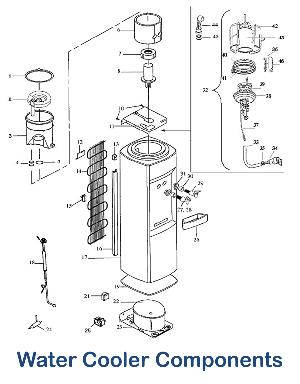Water coolers with built-in dispenser are a common facility found in schools, hospitals, offices and homes. It is an efficient alternative to water bottles and offers a sanitary supply of water for public facilities. All water coolers provide cool water but some units also offer both cold and hot water. Some types even provide hot water, which is hot enough for coffee, instant noodles and soups.
Two Main Types of Water Coolers
Apart from water cooler types, which offer hot water, there are two basic kinds of water coolers. Primarily, there are bottle-less water coolers and bottled water coolers that can both provide cold water. The main difference between the two is that they store water differently. Bottled types mainly use a large, usually clear plastic bottle to store water. More often than not, this kind of water cooler uses the top-load system. Preference can vary from region to region and customer to customer eg the kind of water coolers in Manchester office workers may prefer are those that dispense mineral water from large bottles placed on the top of the cooler.
On the other hand, bottle-less water coolers are connected to the primary water supply and use filtration system to supply clean water. These two kinds of water coolers have control switch for cooling and heating mechanisms of the dispenser.
How a Water Cooler Works to Produce Chilled Water
 Using gravity, water is easily dispensed from the bottle and will pass through an internal filter and into an insulated reservoir. In order to cool water before proper dispensation, water coolers usually have a supply station or a reservoir within the dispenser that stores enough water. This storage area is concentrated with a refrigerant using specialized system of thermoelectricity. Water cooling units with refrigerant use a compressor inside the machine to chill water using Freon, which can easily absorb heat, and lower the level of temperature inside the reservoir.
Using gravity, water is easily dispensed from the bottle and will pass through an internal filter and into an insulated reservoir. In order to cool water before proper dispensation, water coolers usually have a supply station or a reservoir within the dispenser that stores enough water. This storage area is concentrated with a refrigerant using specialized system of thermoelectricity. Water cooling units with refrigerant use a compressor inside the machine to chill water using Freon, which can easily absorb heat, and lower the level of temperature inside the reservoir.
Once the refrigerant passes through the cooling system, it will evaporate into has and will lead to compressed state, in which it can easily absorb heat in the reservoir. As the water cooler dispenses cold water, the system will refill the storage area and the process of refrigeration will start again. If the reservoir becomes totally empty, it may take several minutes before the water cooler makes the water chilled again.
Thermoelectricity and the Peltier Effect
Water coolers employing thermoelectricity to cool water operate using a chilling mechanism grounded on the Peltier effect, which happens when electricity passes into different materials such as metal to ceramics. As electric current pass through from one material to another, the energy will be absorbed into the material with higher conductivity. This will lead to the chilling effect of the water stored in the reservoir. Thermoelectric coolers situated in a hotter setting, on the other hand, may not cool down as fast as water coolers using a compressor mechanism.
Air Replacement Mechanism
As the water cooler dispenses water, it is important that the released water will be replaced by something or else the bottle will collapse because of the pressure from the air outside. Hence, a small air tube will enter the bottle and will float above releasing air pockets. The air tube is also added with a small filter. As water is released from the cooler, it will be replaced by filtered air. The float will also go down as the level of water plummets, which opens a valve that lets water to flow easily.
Water Filtration System
It is highly recommended that the water inside the bottle is already filtered before it is loaded to the cooler. However, some coolers also have built-in filtration system, apparently to make sure that the water is not contaminated. Some water coolers can also purify water using reverse osmosis, in which the water is filtered using a semi permeable membrane that can filter out chemicals like excessive chlorine and other carcinogens.